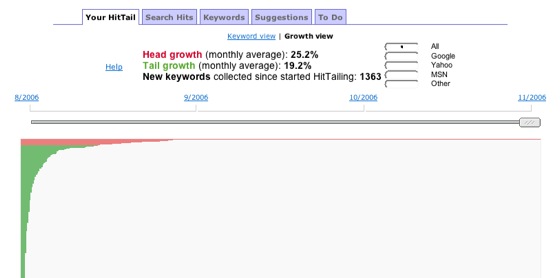Bloggers interested in building search traffic should check out New York based HitTail, a deceptively simple tool that makes suggestions for words to use in blog post titles or topics to write about based on the search terms that are already bringing people to your site. It’s based on the theory of the Long Tail, in this case the idea that the most high profile sources of traffic to your site actually make up less than the total sum of all the traffic from small sources combined. What could be more fun than an easy way to look at the long tail of your blog’s search traffic? I don’t know what the effects or user experience of long term use of this service will be, but it’s certainly worth a look at. In the end, writing quality content, providing unique value and participating in the conversations going on in the blogosphere are probably the most important ways to build traffic. Search is important too, though.
HitTail is essentially log file mining made easy with an algorithm to determine what’s most valuable in the long tail of your search driven traffic. Search queries are considered valuable based on four factors – the number of words in the search, how many pages deep into search results the site visitor dug to find your site and two factors the company won’t disclose.
HitTail is a free service spun off of high profile New York PR firm Connors Communication. (Disclosure: HitTail is a sponsor of our upcoming TechCrunch party in New York.) The HitTail team hopes to offer premium features and service for high volume sites after an initial beta period.
The interface for managing your suggestions is very nice and the company is making available as of today a helpful tool for tracking how your site’s long tail of search has grown over time. Called “Your HitTail,” it’s an Ajax graph that shows what percentage of your search traffic comes from the top 10 search terms, how much comes from the long tail of search terms and what total number of search terms have brought people to your site. Repeat traffic with the same term from the same visitor is only counted once. The idea then is that over several months, you should see total search traffic growing and traffic from terms outside your Top 10 terms growing because you’ve used the suggestions HitTail offers.
The service’s algorithm is still being refined in response to beta use, but I like the basic idea. Will users by “slaves to search” when deciding what to write or how to write about it? Some may, but others may take the suggestions as nothing more than suggestions. HitTail creator Mike Levin says that when someone discovers your site with a multiword query, several pages deep into search results – that’s a meaningful event that you should take seriously. That makes sense to me, especially for sites just beginning to establish themselves.
Levin says the tool will be of no use to splogs because it really needs to be in use for more than a month until tangible results appear – most splogs don’t live that long. The tool also works best for terms off the beaten path, Levin says. For highly competitive terms, more extensive search engine optimization is needed to improve search results – but for noncompetitive terms simply putting the term in your blog post title goes a long way.
Levin says HitTail helps writers focus on what’s almost working well for them already in order to let those terms and topics work even better. I think it’s smart and expect that many bloggers will enjoy giving the service’s suggestions at least a little consideration.
